Have you ever wondered what the Thousand Islands would be like if all the birds disappeared? I have, and I certainly hope that frightening scenario is something that we never experience in our lifetime or that of our descendants!
Since we started cottaging in the area a few years ago, I have been amazed by the rich diversity of birds that can be found in the islands, and just how much interaction we have with them on a daily basis. Not a single day goes by without someone from our group making a comment either about the bird sounds they have heard or something they have observed. Whether it is the honking of the Canada Geese, which starts well before day-break, or the iconic cry of the Loon across the still evening water, the presence of these feathered residents creates an ambience that cannot be equaled and makes for a truly wonderful wilderness experience.
Although I don’t consider myself a true ornithologist I do love watching birds, something I probably inherited from my mother who took great pleasure in watching her feathered friends from her kitchen window.
Armed with our trusty iPad and the “Peterson Birds of North America” app we endeavoured to identify as many different bird species as we could this year. A lot of them, such as the Robins, Black-Capped Chickadees, Blue Jays, and Red-Winged Blackbirds, were pretty easy to catalog. Others, such as the small brown bird that scurried up and down the trunk of the trees looking for insects, were a bit more challenging.
We finally narrowed this particular one down to a Brown Creeper. Other sightings and subsequent identifications included the Eastern Kingbird, the American Goldfinch, the Belted Kingfisher, and the Common Grackle. A flash of bright orange high up in a tree (and sightings from previous years) also let us put the Baltimore Oriole on our list of “observed” birds. There were a few sightings that we were unable to pinpoint exactly – one of them being of a small brownish bird with lovely long tail feathers which we believe to be a type of Flycatcher.
Bird songs and noises…
The wide variety of bird songs and noises that we heard at the island is also something that we found truly fascinating. Ranging from the loud din created by a raucous murder of Crows early in the morning, to the beautiful melody of the Field Sparrow that we heard all through the day, and the hooting of a Great Horned Owl late in the evening, we were serenated by the birds literally from dawn to dusk. Somehow, even the prehistoric squawk of the Great Blue Heron had a certain charm to it!
Observing the radically different patterns of flight that the various types of birds exhibited also provided a lot of entertainment to our group. On one hand you had the Swallows performing their energetic, acrobatic maneuvers over the bay as they picked off unsuspecting bugs in mid-air, and on the other, the slow, methodical flight of the Herons as they skimmed a few centimeters above the water’s surface. Mixed in with these behaviours were the kamikaze-like dives of the Terns as they plummeted at breakneck speed from a great height to pluck a fish out of the water and the seemingly effortless soaring of the hawks and eagles high above. Engineering marvels, one and all!
One of the first things that I do when I arrive at the cottage each year is to clean out the hummingbird feeder and refill it with fresh nectar. It is amazing how quickly these little creatures discover the new food source and we invariably have several beautiful Ruby Throats buzzing in and out on a daily basis. How these tiny, delicate birds find the stamina to carry out their arduous migration each year is beyond me!
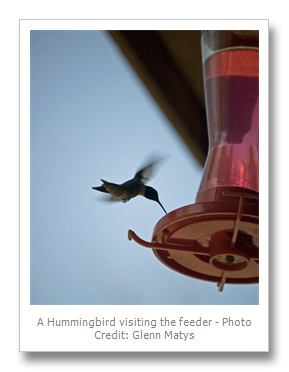
Stale bread never goes to waste at the cottage – as soon as it loses its freshness it is put in the “duck” pile, to be fed to the families of water birds that hang around the island. Our first attempt to feed a family of geese this year was rebuffed, but as soon as the local flock of Seagulls, which was holding court on a nearby rock, realized what was going down they quickly sprang into action. Within minutes we had several screaming gulls circling around in a feeding frenzy and swooping down to scoop up the floating bread bits. Once the bread was all cleaned up they disappeared as quickly as they arrived. A family of Mallard ducks was more receptive to our offerings than the geese were and the five ducklings, under the watchful eye of mama duck, gladly accepted the food offerings, even with two dogs closely watching their every move. The ducks made several return visits during our two weeks and some of us turned into a kid again as we raced to the shore to feed them!
“Foster Parents”
A couple of summers ago we unintentionally became “foster” parents to a family of fledgling Baltimore Orioles at the cottage. I was at the barbecue cleaning things up after lunch when I heard a small, chirping noise coming from the tree above me. When I looked up I saw a little grey fledgling bird with brilliant orange tail feathers looking down at me. Before I could do anything else the little fellow fluttered down to the top of the barbecue and looked at me with his mouth wide open, as if asking, “What’s for lunch?”
I looked around and I saw no signs of a parent bird anywhere. Being a sucker for cute little things I went into the cottage and mixed up some sugar water which I proceeded to feed to the baby bird from a straw. The next thing I knew I heard some more chirping from above and we were soon joined by another sibling, and then another. By this time a crowd of “helpers” had arrived from the cottage and an assembly line was set up to feed the hungry birds the liquid solution as well as some crushed up worms from the bait box. After ingesting a hearty meal the little guys closed their eyes and had a nap. Hoping that the parents would return and look after them we carefully placed the fledglings back up on a high branch in a nearby tree. They were not there the next morning, so they were either reunited with their family or they became owl fodder overnight. We always hoped that it was the first case scenario, but knowing how unforgiving Mother Nature can be, we are afraid that is was probably the latter!
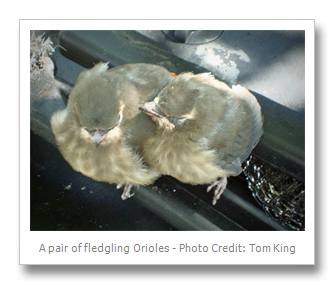
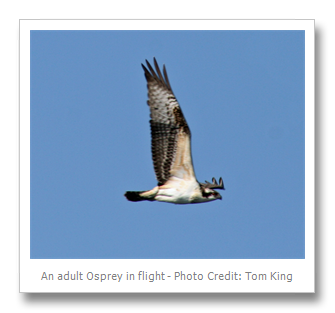
Birds of Prey
Being avid fishermen who spend many hours on the water wetting our lines each summer, we often get the chance to observe a variety of birds of prey in their natural habitats. The sighting of a Bald Eagle soaring majestically overhead is one that is truly remarkable and is a great testament to the efforts of the people who have worked so hard to bring these beautiful birds back to the islands.
The Osprey population is also making a strong comeback and it is always fascinating to watch these predators swoop in and pluck a fish from the water. Red-tailed hawks are prevalent in the area too and can often be seen sitting in trees overlooking the water. We even had a Turkey Vulture, a truly unattractive bird, fly over our boat one morning as it was making its’ rounds looking for his breakfast.
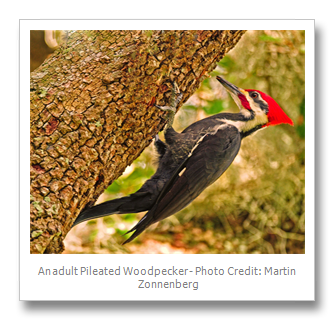
The familiar tap-tap-tapping sound that can be heard emanating from the woods on just about any day signals that a woodpecker is not far away. The Thousand Islands area is home to a wide variety of woodpeckers, both large and small. Probably the most impressive of these birds is the Pileated Woodpecker, whose very distinct call and loud drumming lets everyone know he is around. With a wingspan that can reach 75 centimeters the Pileated is the largest of the woodpeckers. Other woodpeckers that were observed are the Northern Flicker, the Hairy Woodpecker, and the very similar, but much smaller Downy Woodpecker.
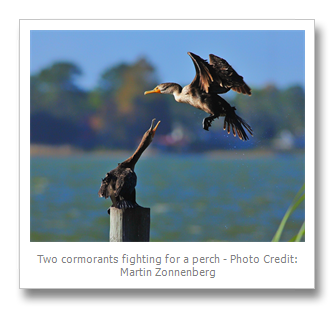
One observation that we have made over the past couple of years is the dramatic increase in the number of Cormorants in the area. Four or five years ago it was a rarity to see one of these birds, but now, they are very widespread in the Thousand Islands region. These birds were nearly wiped out by the use of DDT and other pesticides several years ago and since the ban on those chemicals was instituted they have made a strong comeback.
The Double-Crested Cormorant is a fish eater and must consume up to half a kilogram of food each day to survive. There is a lot of fear that the increasing consumption by the Cormorants is going to have a devastating effect on the stock of bait fish in the river. There is also widespread concern that the increasing population of Cormorants, and the associated large colonies, is going to have detrimental consequences on the long term nesting habits of other native species of birds, such as Gulls, Terns, and Herons, which will, in turn, have a negative effect on their numbers. The issue of the rapid Cormorant population increase has become an emotionally-charged and politicized issue that has polarized many people. There are a lot of groups that are in favour of trying to control the Cormorants through management programs while others are staunch defenders of the bird’s right to exist in nature undisturbed. How this issue will ultimately be resolved is yet to be determined.
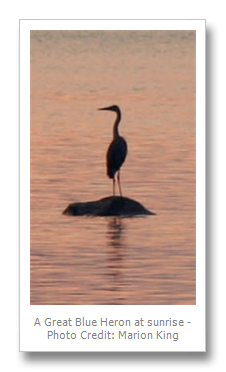
Beauty and character…
So the next time you curse the fact that you were rudely awakened way too early in the morning by a rather vociferous flock of geese or crows and wish that they would go away, please remember how much beauty and character these feathered creatures bring to the islands. Besides, a cheap pair of ear plugs does wonders blocking out the racket!
Happy birding everyone.
By Tom King
Tom King and his wife Marion, have lived in Milton, Ontario for the past twenty-five years, where they both worked and raised their family of three children; Kris, Mike and Becca. Tom still has a strong attachment to the Thousand Islands, having grown up in Gananoque and being a “river rat” from a very early age. The family tries to return to the islands every summer and for the past few years have been renting a cottage on Sampson (a.k.a. Heritage) Island, just out from Gananoque.
Editor’s Note: The author, Tom King, hopes that his article will interest others to write about birding in the region. Do you have a story to tell? What unusual birds have you sighted? Are there techniques that you could pass on to our readers? We look forward to hearing from you. We also thank Martin Zonnenberg for sharing some of his photographs for this article.